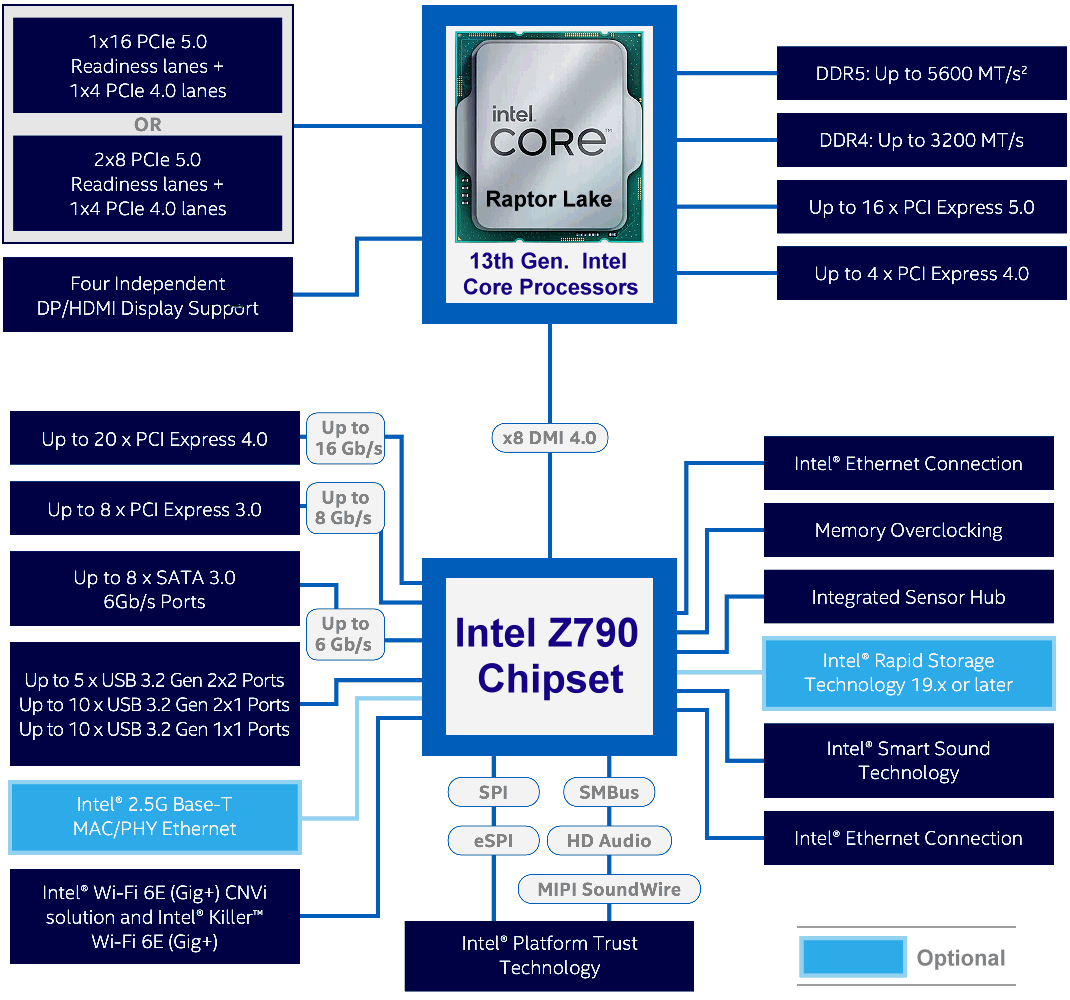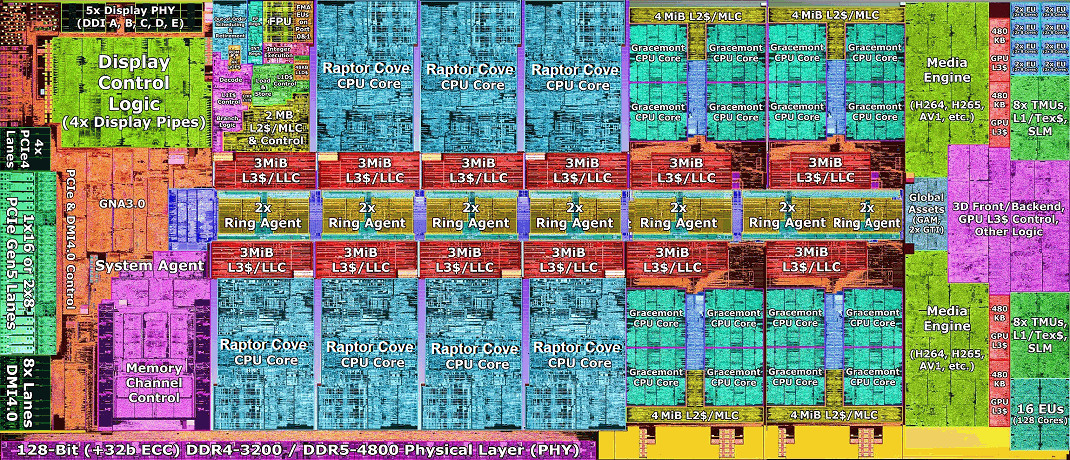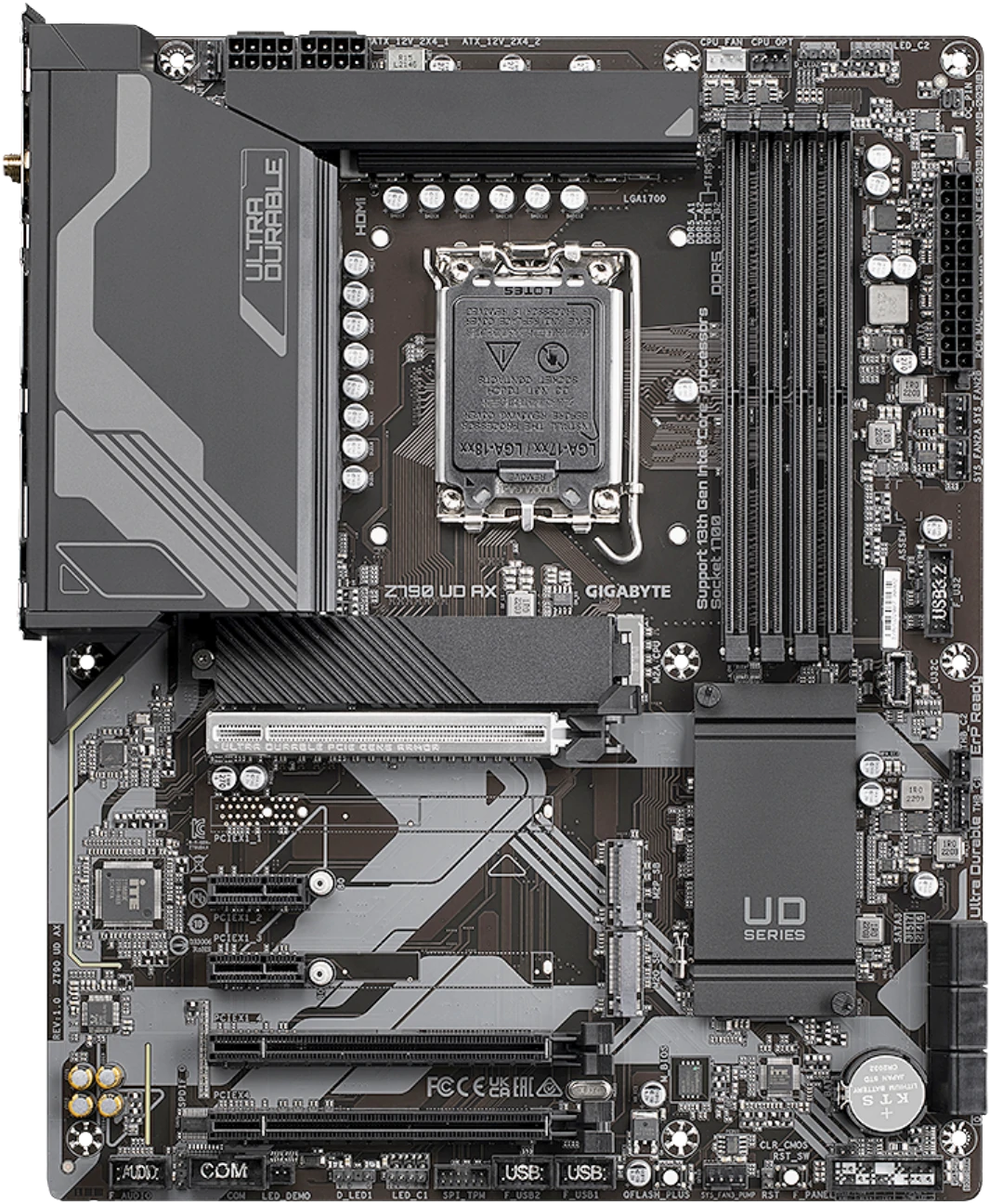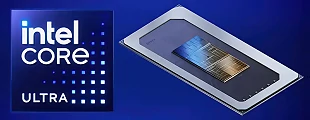PCI-Express 5.0 Motherboard - Chipset Z790 |
As expected, Intel continued the development of the 12th generation of processors, and they are the 13th and 14th generations of Raptor Lake family of microprocessors which has more cores, larger cache, higher operating frequency and support for 4K graphics. The basic features of this new generations of processors are:
The table on the previous page contains data for the most powerful processor from the first series of Raptor Lake family of microprocessors.
While the Z690 put out up to 12 downstream PCIe Gen 4 lanes and up to 16 downstream PCIe Gen 3 lanes; the new Z790 puts out up to 20 downstream PCIe Gen 4 lanes, and up to 8 downstream PCIe Gen 3 lanes. Both chipsets use DMI 4.0x8 as the chipset bus (connection between the processor and chipset), with bandwidth comparable to PCI-Express 4.0x8 (128 Gbps per direction). Z790 allows motherboard designers to wire out up to five M.2 NVMe Gen 4 slots attached to the chipset, or deploy more numbers of high-bandwidth onboard devices than those possible with Z690; devices such as discrete USB host controllers, Thunderbolt 80 Gbps controllers, etc, besides a handful PCIe Gen 4 slots. The 8 PCIe Gen 3 lanes should be enough for lower-bandwidth onboard devices, such as WLAN cards, onboard 2.5 GbE NIC, or even a 10 GbE NIC. The differences are shown in the table on the previous page.

|
| Figure 3.5.64 Block scheme of chipset Intel Z790. |
The processor Core i9-13900K supports PCIe 5.0x16 (or 2 x PCIe 5.0x8) slots for graphics and PCIe 4.0x4 slots for M.2 memory next to the CPU and on the motherboard. Up to 128 GB of working memory (DRAM) can be inserted into the memory slots, with a fairly high operating clock for DDR5 type DRAM. Just to clarify DDR5 memory is not backwards compatible with DDR4 memory, it's a completely different DIMM slot. This means that the motherboards are different according to the built in type of memory for the same chipset.
The Intel Core i9-13900K is a desktop processor with 24 cores, 8 P-Cores and 16 E-Cores, 32 Threads and larger Cache. It is part of the Core i9 lineup at base of 'Intel 7', using the Raptor Lake architecture with Socket 1700. Core i9-13900K has 36 MB of L3 cache and operates at 3 GHz by default, but can boost up to 5.8 GHz, depending on the workload. Intel is building the Core i9-13900K on a 10 nm production process, with much more transistors in die then predecessors. You may freely adjust the unlocked multiplier on Core i9-13900K, which simplifies overclocking greatly, as you can easily dial in any overclocking frequency. With a TDP of 125 W, the Core i9-13900K consumes a lot of power, so good cooling is definitely needed. Intel's processor supports DDR4 and DDR5 memory with a dual-channel interface. ECC memory is supported, too, which is an important capability for mission-critical systems, to avoid data corruption. For communication with other components in the computer, Core i9-13900K uses a PCI-Express Gen 5 connection. This processor features the UHD Graphics 770 integrated graphics solution. Hardware virtualization is available on the Core i9-13900K, which greatly improves virtual machine performance. Additionally, IOMMU virtualization (PCI passthrough) is supported, so that guest virtual machines may directly use host hardware. Programs using Advanced Vector Extensions (AVX) will run on this processor, boosting performance for calculation-heavy applications. Besides AVX, Intel is including the newer AVX2 standard, too, but not AVX-512. Die has 227.52 square mm.

|
| Figure 3.5.65 Die of 'Intel Core i9-13900K' Processor. |
There is nothing missing on the die of this most powerful processor. Compared to the previous generation, the number of both types of cores has been increased, the buffer size of all cores has been increased, the operating clocks have been increased and much more has been added. The support for multimedia content processing (H264, H265 ...) is particularly pleasing. A comparison table with previous processors is shown in the table on the previous page. 10 nm technology is still used and the thirteenth generation of these microprocessors is possibly a template for the next generation that will be made in a finer technology.
Which motherboard to get? Manufacturers offer very powerful motherboards that are able to serve multiple graphics cards, to simpler ones whose primary task is variety and lower price. One of them, from GIGABYTE, was shown on the previous page, and on this page, a similar motherboard with the richest features from this series is shown. Its special feature is the largest number of PCI-e slots, so it is possible to use cards for different purposes, such as the card in the Figure 3.5.61, which comes in very handy if you are looking for a USB port with higher current capabilities. The 13th series flagship processor from the 'Intel 7' product stack has quite a bit of dissipation (125-250 W), which requires more CPU power connectors on the motherboard as seen in the upper left corner of the motherboard (2 connectors with 8 pins). The same series motherboards for the z690 chipset have fewer CPU power pins. It is possible to install three M.2 devices on the motherboard, which is enough for a very functional and fast computer without the need for disk devices.

|
| Figure 3.5.66 Motherbord 'Gigabyte Z790 UD AX (rev. 1.x)'. |
Key Features of motherbord 'Gigabyte Z790 UD AX' are:
So, the motherboard supports two generations of microprocessors, which was rare until now. In addition, 13th generation processors are not compatible with the z690 chipset for 12th generation processors without upgrading the motherboard BIOS for z690 chipset, which is expected by the manufacturer. As already stated before, a motherboard with as many PCIe slots as possible was chosen as an example, and the next picture shows the connectors for connecting peripheral devices. The motherboard shown here is particularly pleased with the cooler that covers all the components where the connectors are located, which at the same time protects the mentioned components from the flow of hot air from the processor cooler (Advanced Thermal Design).

|
| Figure 3.5.67 Connectors of motherboard 'Gigabyte Z790 UD AX'. |
The rear ports, viewed from left to right, are:
If the number of ports is insufficient, additional internal ports are build in on the motherboard, which are connected to a dedicated card holder (bracket) with external ports. These internal connectors are also useful when you want to connect the connectors integrated into the computer case. If USB devices of higher consumption are connected, it is useful to install a USB hub, as shown at the card in Figure 3.5.61. Functionality of an audio jack can be change by using the audio software.
SUMMARY:
What does Intel say? With an increase in core count, these processors continue to utilize Intel’s performance hybrid architecture to optimize your gaming, content creation, and productivity. Leverage industry-first bandwidth of up to 16 PCIe 5.0 lanes and DDR5 memory up to 5600 MT/s. Supercharge your CPU performance with a powerful suite of tuning and overclocking tools. Enjoy your favorite experiences in up to 4 simultaneous 4K60 displays or up to 8K60 HDR Video with dynamic noise suppression. Support for the Intel 700 series chipsets and backwards compatibility with the Intel 600 series chipsets allow you to access the features you need for any task. Whether you are working, streaming, gaming, or creating, the 13th Gen Intel Core desktop processors deliver the next generation of breakthrough performance. With a BIOS upgrade, 13th generation motherboards will accept 14th generation of microprocessors.
There's really nothing to complain about, but the cash outlay is still too high. The market still does not have many different graphics cards according to the PCIe 5.0 standard, nor is there a large offer of M.2 modules for the PCIe 4.0 standard and DDR5 memory. The cost may be worth it if you really urgently need such a powerful processor, regarding hardware support (CPU) for multimedia content. In addition, this generation of processors is based on 10 nm lithography, which the competitors have already surpassed, and it seems to me that this group of microprocessors is the final work before the transition to finer lithography in the next series of microprocessors codenamed 'Meteor Lake-S' and it is questionable how they will be backwards compatible with older chipsets. Then it will be seen who is the 'boss' in the production of microprocessors for PCs - Intel or AMD.
 So, in January 2024. Intel releases two new entries in its Core lineup of microprocessors: The Intel Core 14th generation for desktop ('Raptor Lake-S' in Intel 7, 10 nm technology) and the laptop-focused Intel Core Ultra ('Meteor Lake' in Intel 4, 7 nm technology). Intel Core processors feature have new optimized hybrid architecture and industry-leading technology that enable to use computer over gaming and creation. With even more efficiency cores, performance are better for streaming video, plaing music, and encoding video - all while gaming. With high-bandwidth DDR5 RAM are smoothly run graphics-heavy PC games and video-editing applications, as well as numerous programs and browser tabs all at once. As usual, the most improved processors are for notebooks. The new technological leap brings the following innovations:
So, in January 2024. Intel releases two new entries in its Core lineup of microprocessors: The Intel Core 14th generation for desktop ('Raptor Lake-S' in Intel 7, 10 nm technology) and the laptop-focused Intel Core Ultra ('Meteor Lake' in Intel 4, 7 nm technology). Intel Core processors feature have new optimized hybrid architecture and industry-leading technology that enable to use computer over gaming and creation. With even more efficiency cores, performance are better for streaming video, plaing music, and encoding video - all while gaming. With high-bandwidth DDR5 RAM are smoothly run graphics-heavy PC games and video-editing applications, as well as numerous programs and browser tabs all at once. As usual, the most improved processors are for notebooks. The new technological leap brings the following innovations:
With a completely new hybrid design, 3D performance is accelerated in terms of graphics and AI capabilities. So now, customers can enjoy exciting new Artificial Intelligence (AI) capabilities, like real-time language translation, automation inferencing, and enhanced gaming environments - while conserving power.
|
Citing of this page: Radic, Drago. " Informatics Alphabet " Split-Croatia. {Date of access}; https://informatics.buzdo.com/file. Copyright © by Drago Radic. All rights reserved. | Disclaimer |